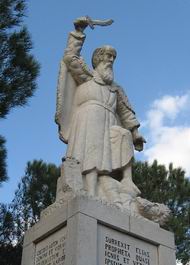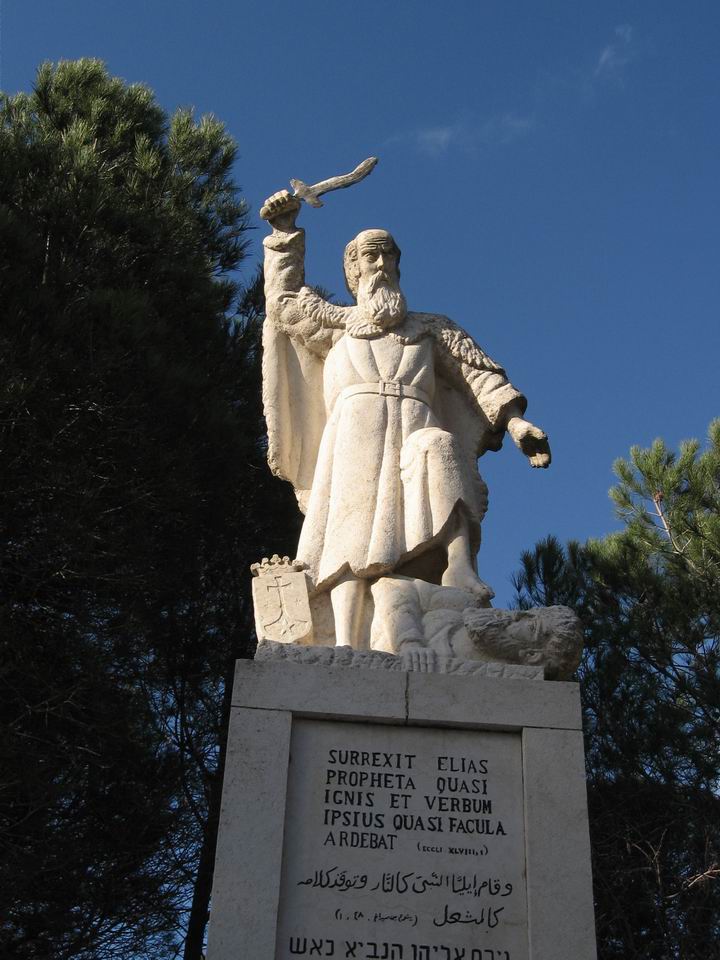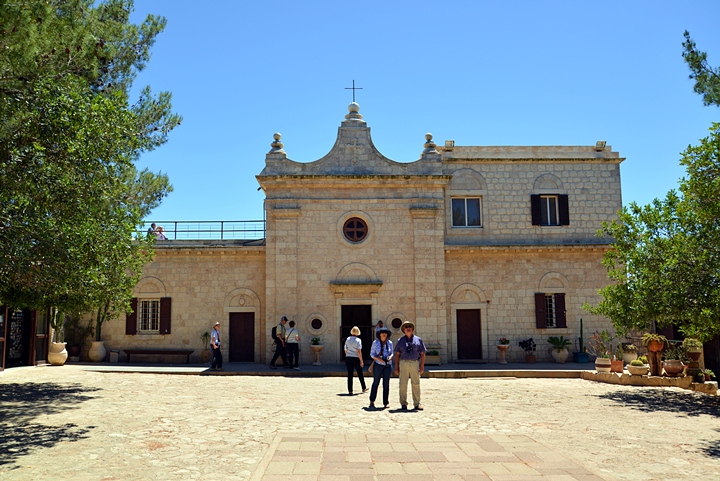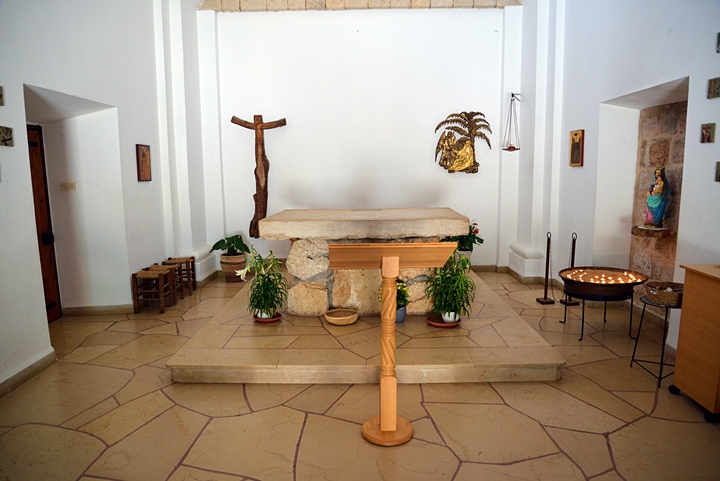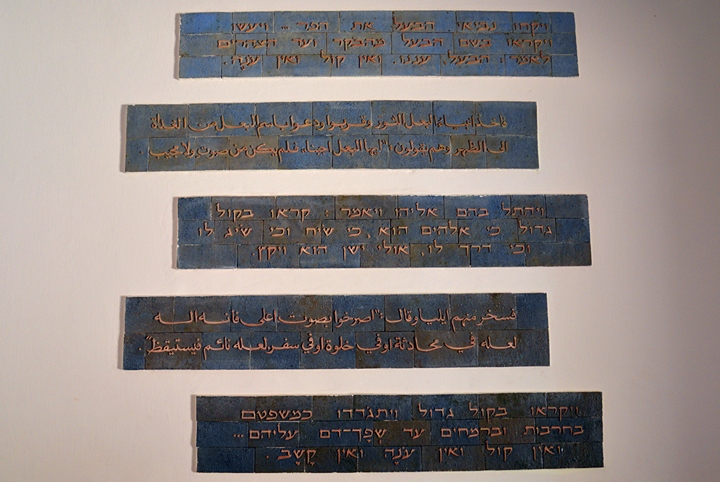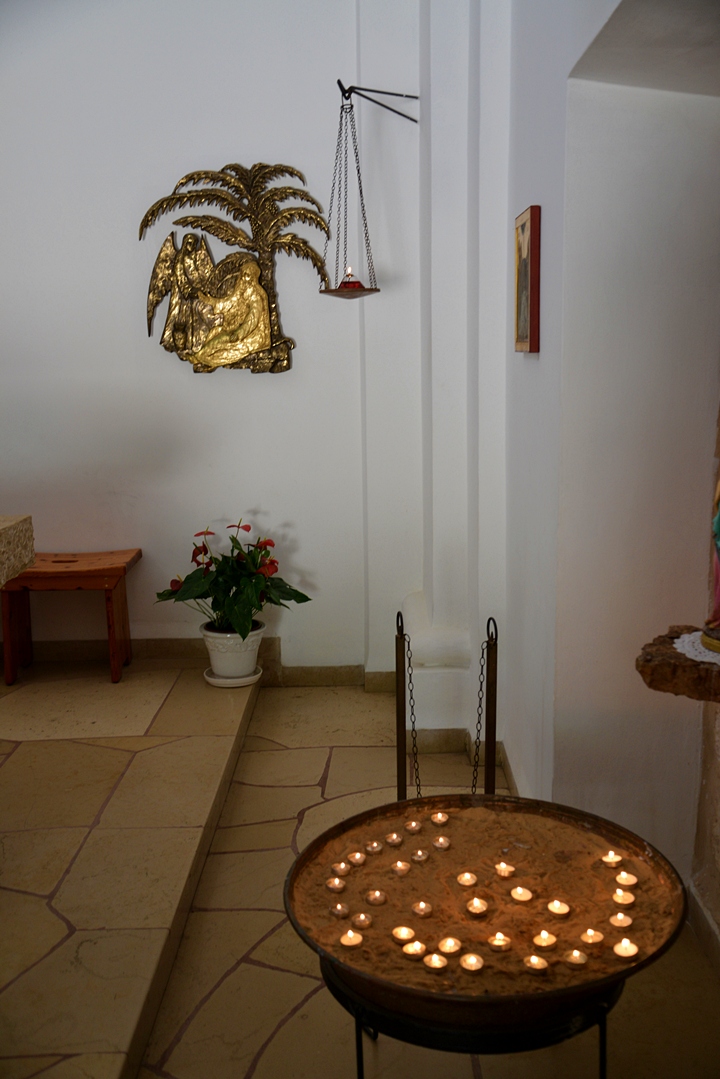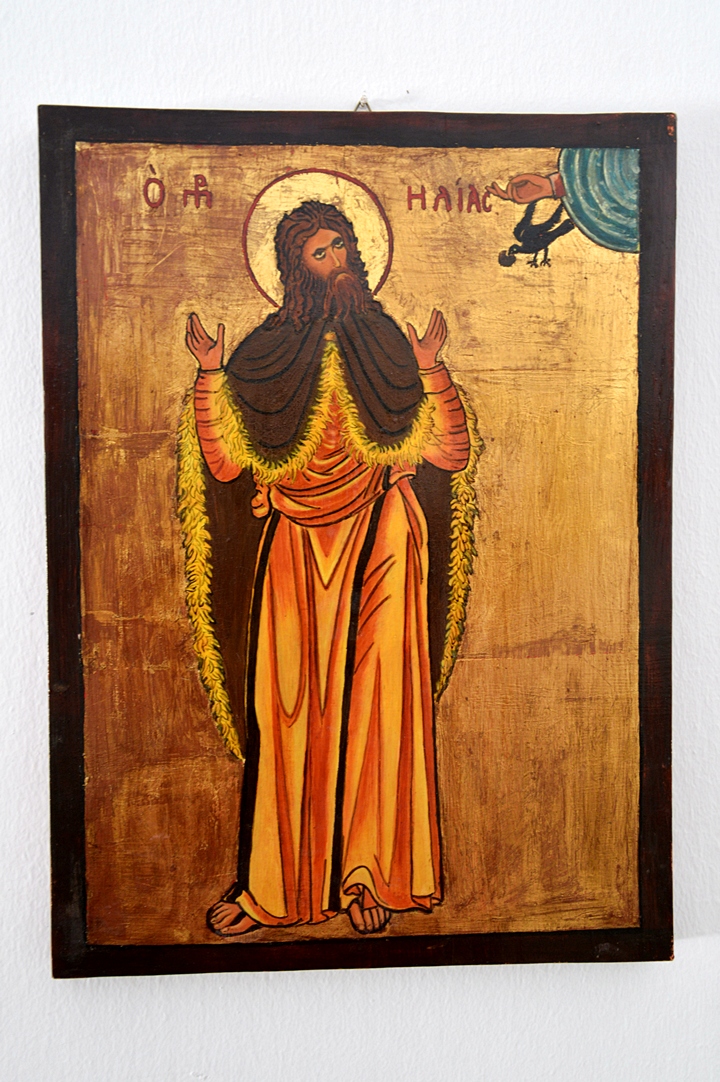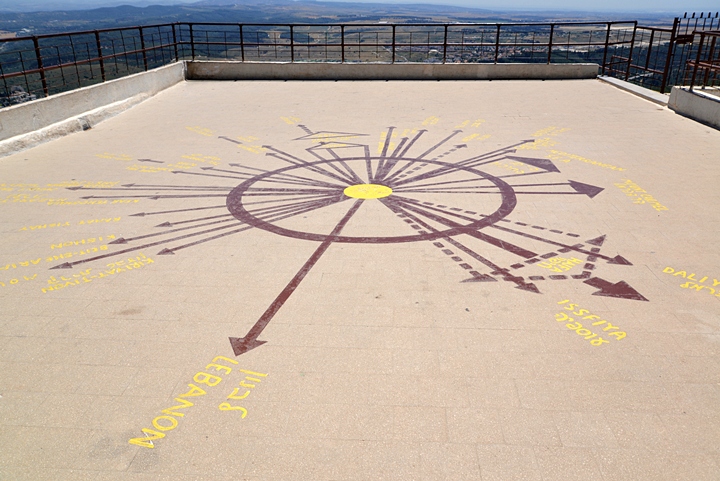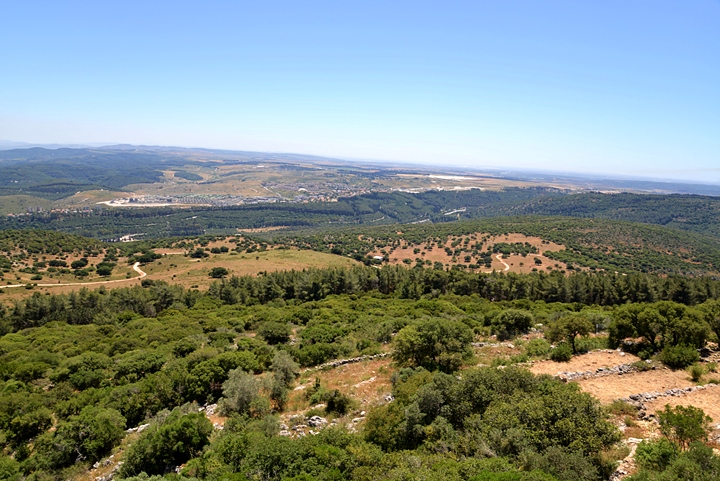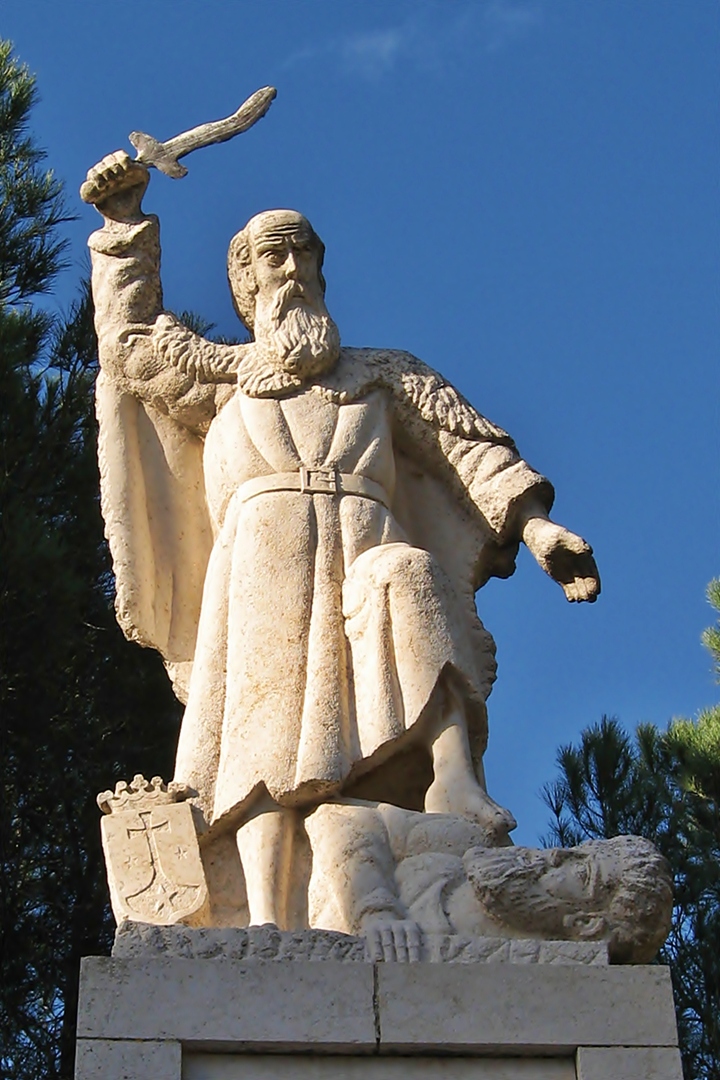Keren-Carmel (Mukhraka) is a hill on the south-eastern side of mount Carmel. On the hill is a small Carmelite order church named after Elijah and the site of his victory over the Baal prophets.
Home > Sites > Carmel > Keren-Carmel (Carmelite order church, Mukhraka)
Contents:
Background
Location
History
Carmelites
Photos
* Aerial
* Courtyard
* Church
* Terrace
* Panorama
Biblical
Identification
Other refs
Etymology
Links
Background:
Keren-Carmel (“Horn of Carmel”) is a hill (474M) on the south-eastern side of mount Carmel. On the hill, covered with bush, is a small Carmelite order church which commemorates the victory of prophet Elijah over the Baal prophets. In the front yard of the church is a remarkable statue of the Prophet Elijah slaughtering a Baal prophet, and on its terrace is a beautiful panorama.
1 Kings 18:40: “…and Elijah brought them down to the brook Kishon, and slew them there.”
Location:
The site is located south-east to the outskirts of Dalyat-El-Carmel, one of the two large Druze villages on mount Carmel. A narrow and winding road from Dalyat-El-Carmel leads to the church through a clearing in the bush. The church is located on the highest hill on the south-east side of mount Carmel, facing Yokneam and Yizreel (Jezreel) valley.
History:
In Biblical times there were few sites on the Carmel (3 Canaanite sites, 7 Israelite sites), and the area around Keren Carmel was empty at that time. The Biblical sites were located down in the Yizreel valley, where it was easier to farm the land and closer to the trade routes. However, there were altars on high places, as described in 1 Kings 18 text, such as an altar for God (30: “And he repaired the altar of the LORD that was broken down”), and more sites for the Baal (“And they leaped upon the altar which was made”). This was probably why King Ahab and Elijah selected the site for the great contest – God versus Baal.
There were still very few sites in the Carmel in the Persian/Hellenistic period, and the only site at this area was a small village on Khirbet Dubbah, located on the hill north to Keren Carmel.
However, the late Roman/Byzantine period (1-7 century AD) witnessed a huge increase of sites across the entire Carmel region, with dozens of new sites. There were 4 villages within the close 1KM radius of Keren-Carmel: Khirbet Dubbah (on the hill north to Keren-Carmel), Khirbet Kerach (north-west to the site), Khirbet Addah (north to the site) and Khirbet Netzurah (south to the site). At a 5KM radius there were more than a dozen Roman/Byzantine sites, all were small agriculture villages.
During the Arab period all these sites were eliminated. Later, during the Crusaders and the Mamlukes (10th-15th century) only few of the 100 Carmel villages were repopulated, including Khirbet Dubbah and Khirbet Netzura (Mantsura).
The church, according to tradition, was built over a Byzantine church. The Carmelite church, St. Elyas (Elijah), dates to 1883 and is managed by the Carmelite order.
Carmelite Order:
The Carmelites are a Catholic order of monks, one of the oldest in the Holy Land, and named after Mount Carmel. They were founded on Mount Carmel more than 800 years ago, starting from a number of Crusaders who went to seclusion in the caves on mount Carmel, and lead by the Frenchman Berthold (died 1188). In about 1200 their first church (St. Brocardus) was built in Siakh (bush) creek on the western slopes of mount Carmel, but were butchered by the Arabs after the defeat of the Crusaders.
The primary saint of the Carmelites is the Prophet Elijah. Their symbol, as engraved on the stones in front of the church, is seen on the right. Around their symbol are the Latin text (1 Kings 19:10): “…I have been very jealous for the LORD God of hosts”.
The Carmelite monk dresses in brown and walks with biblical sandals. The center of this order is in Rome, and is widespread around the world.
Photos:
(a) Aerial Views:
The church, seen on top of the highest hill in this area, is surrounded by a thick patch of low bushes, which is typical of park areas of Mount Carmel.
Click on the photos to view in higher resolution…
The church is located on top of the hill overlooking the valley of Jezreel (Yizreel). These aerial views are from the west side.
(b) The courtyard:
In the courtyard of the church is the famous status of Elijah slaughtering the Baal prophets. The words engraved on the stone base on all four sides are selected Biblical texts (see 1 Kings below). This statue is new – it replaced an earlier version that was smashed by the invading Arab army during the Independence war (1948).
The entrance to the St. Elyas (Elijah) church is seen in the following photo. The panorama terrace is on the left side, accessible through the gift shop.
(c) Church:
Inside the church – a stone altar. In the base of the altar are 12 local stones, as described in Elijah’s altar (“…and Elijah took twelve stones, according to the number of the tribes…”).
On the wall are Biblical verses related to the contest between Elijah and the Baal prophets.
A detail of the side of the altar, with candles lit by the visitors.
On the wall is a metal statue illustrating the prophet in the desert, after fleeing from the wicked queen Jezebel (1 Kings 19). The angel touches Elijah, sending him to a journey of forty days and nights to Horeb.
A picture of Elijah in on the wall. The Greek letters on the right are Ηλίας, or: Elias (Elijah). The prophet is often illustrated with a raven bringing food while he was hiding (1 Kings 17: 7): “And the ravens brought him bread and flesh in the morning, and bread and flesh in the evening; and he drank of the brook”.
(c) The terrace:
On the terrace on top of the church is a spectacular view of Yizreel (Jezreel) valley, the Menashe hills to the east, and the south of Mount Carmel. On the terrace are directed arrows pointing to the major points of interest.
In the center background you can see the outskirts of Nazareth, Mount Tabor, Mount Hamoreh and Mount Gilboa. On a clear day you can see as far as mount Hermon. It is indeed an amazing scene which is worth the visit!
A panoramic view of the sights from the terrace is seen in this next photo. Pressing on this picture will pop up the panoramic viewer. Using this flash-based panoramic viewer, you can move around, zooming in and out – viewing the site in the amazing full screen mode (like you are really there). Points of interest are indicated on the view. It may take minutes to upload, but then its worth the waiting time.
To open the viewer, simply click on the photo, then tour the area around:
- Scenic road:
Selecting one of the views from this panorama, the photo below shows the southern side of Mount Carmel. In the foreground is Khirbet Netzura, and the nature road that travels around it.
Note that this road is a recommended ride. it is accessed from the fork just before climbing up to the hill of the church. The scenic road takes you through the Park of Carmel.
In the center background is part of the city of Yokneam, located on the western side of the Menashe hills. On the right background – past the south-west side of mount Carmel – is the Med sea, as described in the Biblical text.
Biblical References:
1 Kings 18: 17-46
This is the text on Elijah the prophet and the slaughter of the Baal prophets. King Ahab contested the prophet against his false prophets, and Elijah -with the help of the true God – prevailed.
“And it came to pass, when Ahab saw Elijah, that Ahab said unto him, Art thou he that troubleth Israel? And he answered, I have not troubled Israel; but thou, and thy father’s house, in that ye have forsaken the commandments of the LORD, and thou hast followed Baalim. Now therefore send, and gather to me all Israel unto mount Carmel, and the prophets of Baal four hundred and fifty, and the prophets of the groves four hundred, which eat at Jezebel’s table. So Ahab sent unto all the children of Israel, and gathered the prophets together unto mount Carmel. And Elijah came unto all the people, and said, How long halt ye between two opinions? if the LORD be God, follow him: but if Baal, then follow him. And the people answered him not a word. Then said Elijah unto the people, I, even I only, remain a prophet of the LORD; but Baal’s prophets are four hundred and fifty men. Let them therefore give us two bullocks; and let them choose one bullock for themselves, and cut it in pieces, and lay it on wood, and put no fire under: and I will dress the other bullock, and lay it on wood, and put no fire under: And call ye on the name of your gods, and I will call on the name of the LORD: and the God that answereth by fire, let him be God. And all the people answered and said, It is well spoken.
And Elijah said unto the prophets of Baal, Choose you one bullock for yourselves, and dress it first; for ye are many; and call on the name of your gods, but put no fire under. And they took the bullock which was given them, and they dressed it, and called on the name of Baal from morning even until noon, saying, O Baal, hear us. But there was no voice, nor any that answered. And they leaped upon the altar which was made. And it came to pass at noon, that Elijah mocked them, and said, Cry aloud: for he is a god; either he is talking, or he is pursuing, or he is in a journey, or peradventure he sleepeth, and must be awaked. And they cried aloud, and cut themselves after their manner with knives and lancets, till the blood gushed out upon them. And it came to pass, when midday was past, and they prophesied until the time of the offering of the evening sacrifice, that there was neither voice, nor any to answer, nor any that regarded. And Elijah said unto all the people, Come near unto me. And all the people came near unto him. And he repaired the altar of the LORD that was broken down. And Elijah took twelve stones, according to the number of the tribes of the sons of Jacob, unto whom the word of the LORD came, saying, Israel shall be thy name: And with the stones he built an altar in the name of the LORD: and he made a trench about the altar, as great as would contain two measures of seed. And he put the wood in order, and cut the bullock in pieces, and laid him on the wood, and said, Fill four barrels with water, and pour it on the burnt sacrifice, and on the wood. And he said, Do it the second time. And they did it the second time. And he said, Do it the third time. And they did it the third time. And the water ran round about the altar; and he filled the trench also with water. And it came to pass at the time of the offering of the evening sacrifice, that Elijah the prophet came near, and said, LORD God of Abraham, Isaac, and of Israel, let it be known this day that thou art God in Israel, and that I am thy servant, and that I have done all these things at thy word. Hear me, O LORD, hear me, that this people may know that thou art the LORD God, and that thou hast turned their heart back again. Then the fire of the LORD fell, and consumed the burnt sacrifice, and the wood, and the stones, and the dust, and licked up the water that was in the trench. And when all the people saw it, they fell on their faces: and they said, The LORD, he is the God; the LORD, he is the God. And Elijah said unto them, Take the prophets of Baal; let not one of them escape. And they took them: and Elijah brought them down to the brook Kishon, and slew them there.
And Elijah said unto Ahab, Get thee up, eat and drink; for there is a sound of abundance of rain. So Ahab went up to eat and to drink. And Elijah went up to the top of Carmel; and he cast himself down upon the earth, and put his face between his knees, And said to his servant, Go up now, look toward the sea. And he went up, and looked, and said, There is nothing. And he said, Go again seven times. And it came to pass at the seventh time, that he said, Behold, there ariseth a little cloud out of the sea, like a man’s hand. And he said, Go up, say unto Ahab, Prepare thy chariot, and get thee down that the rain stop thee not. And it came to pass in the mean while, that the heaven was black with clouds and wind, and there was a great rain. And Ahab rode, and went to Jezreel. And the hand of the LORD was on Elijah; and he girded up his loins, and ran before Ahab to the entrance of Jezreel”.
Biblical Identification:
The text above fits the site and topography of Keren-Carmel:
- the Kishon brook is indeed below the site (“and Elijah brought them down to the brook Kishon”);
- the hill is is the “top” of the Carmel at this area of Mount Carmel (“And Elijah went up to the top of Carmel”);
- only from this hill you can see the clouds coming from the sea (“Behold, there ariseth a little cloud out of the sea”).
- there is a road that connects Keren-Carmel to Yizreel valley below, making it possible for the travels to the Kishon brook
This description perfectly fits Keren-Carmel or one of the hills north of the site. Another prime candidate is Khirbet Dubbah, located on the next hill to the North. Both fit the Biblical description.
What is the location of the slaughtering of the Baal prophets? While driving through the road before Yokneam you often wonder where this all happened. One of the Biblical sites is Tell Kasis, which is according to tradition the likely site.
Other References:
“Haifa” Sep 24, 1883
- Laurence Oliphant “Haifa, or Life in Modern Palestine”
His article was published on Sep 24, 1883 with the title “My inquiries on the Carmel”, where he tells his readers about his visit to the Mukhraka (Keren-Carmel). When he visited this place the Carmelites were just building the church, and according to his report they were reusing local antique stones to build it. This angered Laurence, but he took comfort in his idea that the place of the church was not the site of Elijah’s altar. His reason is that the biblical text tells that Elijah requested his servant to “go up” in order to see the clouds on the sea, and on Keren-Carmel there is no reason for climbing up, since the sea is fully visible. In fact, he places the site 1 mile away (probably north, in Khirbet Din) where he found a pile of stones that might be Elijah’s altar. That site is a better candidate, as his view, since there is a need to climb up for viewing the sea, and there is an easy path down to the Kishon.
We recommend to read from this chapter, and others, in this charming book. The journeys in the 19th century are a real juxtaposition to the modern life, and his descriptions are very close to the Biblical life. For example, a 15 minute drive from downtown Haifa to the top of the Carmel took him a whole day by horseback…
His archaeological knowledge is limited; the Holy Land surveys only started at those times. Therefore, some of his analysis are based on false facts, for example the age of the ancient sites on the Carmel. But we must remember his contribution to the interest of the worldwide public to the research of the Holy Land. As a reporter, his articles ignited the imagination and curiosity of the World… Indeed, a pioneer of Bible Walks!
It is a recommended book for the period of rediscovering the Holy Land.
Etymology (behind the name):
-
Mukhraka (Muhraka) – Arabic: the fire. It is based on the fire from God that lit up the altar, showing that God is the true and only God. As per 1 Kings 18: 38: “Then the fire of the LORD fell, and consumed the burnt sacrifice, and the wood, and the stones, and the dust, and licked up the water that was in the trench”.
-
Keren – In Hebrew: horn, since the hill stands out like a horn over the Carmel.
-
Elijah – In Hebrew: Eliyahu. Means in Hebrew: Eli (my God) + Yahu (the Lord, the Hebrew God). Thus the name means “The Lord is my God”. Elijah came from a place called Tishbi, in the region of Gilad – east to the Jordan river. Biblical reference: 1 Kings 17:1: “And Elijah the Tishbite, who was of the inhabitants of Gilead, said unto Ahab, As the LORD God of Israel liveth, before whom I stand, there shall not be dew nor rain these years, but according to my word”.
-
Carmel – in Hebrew: Cerem is vineyard, El is God. The name means “vineyard of the God”.
-
Ahab – In Hebrew: Ach is brother and Av is father. The name means: “my father (God) is my brother”. Ahab was one of the great Kings of Israel.
Links:
* External:
* Internal:
- Drone Aerial views – collection of Biblical sites from the air
- Khirbet Dubbah – nearby Roman ruins
BibleWalks.com – walk with us through the sites of the Holy Land
Haifa <<<—previous site —-<<<All Sites>>>—next Carmel site—>>> Dubbah
This page was last updated on Nov 19, 2014 (Added new photos and aerial views)
Sponsored links:
